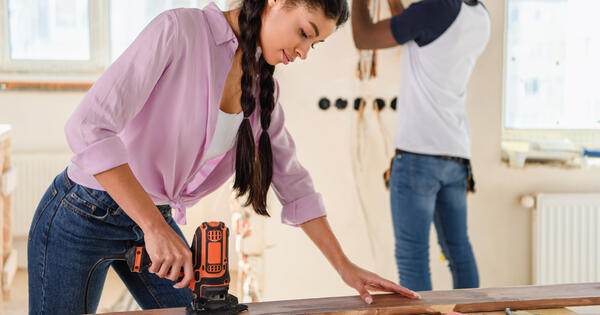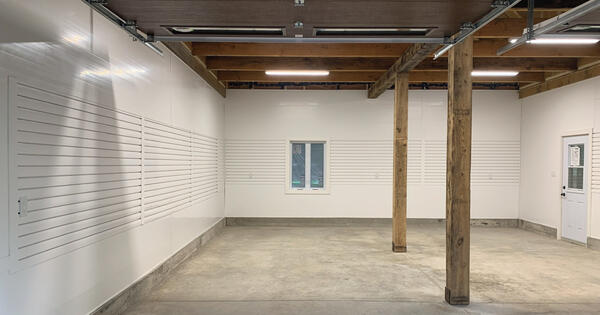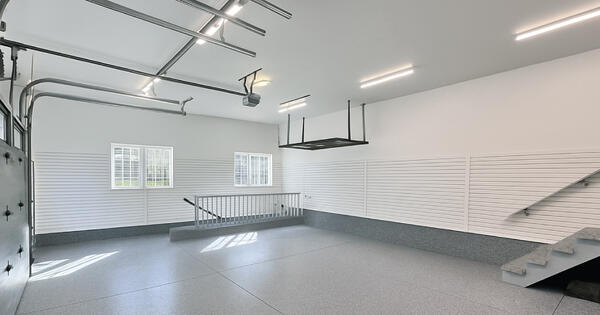Are you looking to breathe new life into your mobile home? One significant but often overlooked upgrade is the ceiling. A ceiling refresh can revamp the entire look and feel of your space. In this blog post, we'll delve into the why and how of upgrading your mobile home ceiling panels, making your living space look its best and last longer.
Unique Challenges of Mobile Homes
Upgrading your mobile home ceiling panels isn't the same as sprucing up the ceiling in a standard house. In a mobile home, you face unique challenges you need to consider ensuring you choose the right material for your space, including:
- Low Clearance. Mobile homes come with lower ceiling heights compared to traditional houses. In a typical mobile home, you might have only around 7-8 feet of vertical space to work with. This height difference can make the choice of materials and installation methods crucial to avoid creating a claustrophobic ambiance.
- Weight Constraints. Mobile homes aren't known for their robust structures. It's important to remember that weight can significantly affect the integrity of your mobile home. Opt for lightweight materials that don't strain your home's framework. Not only will this prevent potential structural issues, but it'll also make the installation process much more manageable.
- Moisture Concerns. Due to the close quarters of mobile home parks and varying climate conditions, mobile homes are more susceptible to moisture problems than standard detached homes. Picking the right ceiling material is essential to prevent unsightly, and potentially unhealthy, mold and mildew growth. Your choice should resist moisture and humidity and be easy to clean and maintain.
- Mobility. Remember, it's called a mobile home for a reason. If you ever decide to relocate your home, consider the implications of your ceiling choice. Durable materials that won’t crack or be damaged during moving are essential.


Assessing and Preparing Your Mobile Home Ceiling for an Upgrade
efore you dive into a ceiling upgrade, it's crucial to assess your existing ceiling thoroughly for any signs of problems or damage you need to address before starting your project. Here’s what to do:
- Look Up. Examine your ceiling for any visible signs of damage. Pay close attention to cracks, stains, or any sagging areas. These are clear red flags that your ceiling needs attention.
- Touch and Feel. Run your hand across the ceiling's surface. Are there any soft or spongy areas? This can be a sign of water damage, possibly indicating a leak in your roof.
- Sagging Spots. If you notice your ceiling is sagging, that's a clear sign of trouble. Before installing new panels, it's imperative to address this issue, as it may indicate structural problems or water damage that need fixing.
- Inspect for Mold. Mold is more than just an eyesore; it's a health hazard. Check your ceiling thoroughly for any patches of mold or mildew. Address this issue promptly before proceeding with your ceiling upgrade.
- Leak Traces. Inspect your ceiling for any water stains or marks. These may indicate past or current leaks from your roof. Ensure these issues are resolved before moving on with interior improvements.

1. Drywall
Like in standard homes, painted drywall is a popular choice for mobile home walls and ceilings despite its well-known problems.
Pros:
Cost-Effective. Drywall is affordable and readily available at most home improvement stores.
Smooth Finish. When installed properly, drywall provides a smooth, clean finish and can be readily painted to complement the design of your space.
Cons:
Moisture Vulnerability. Drywall is not ideal for moisture-prone environments, as it can become damaged and warped when exposed to high humidity.
Installation Difficulties. Drywall is very messy to install (especially when you have to sand it!) and requires mudding, taping, priming, and painting. If you aren’t experienced, you’ll have to hire expensive professional help.
Weight Concerns. Drywall is relatively heavy, which may necessitate reinforcing your mobile home's structure to support the added weight.
Challenging Repairs. Repairing damaged drywall can be complex, requiring significant effort to match the texture and finish of the rest of your ceilings.

2. Drop Ceilings
Drop ceiling tiles are suspended from a grid system that’s attached to the ceiling of your mobile home.
Pros:
Accessibility. Drop ceilings offer easy access to electrical and plumbing components that run along your ceiling, making future repairs or updates straightforward.
Conceal Imperfections. Drop ceilings can effectively hide any visible imperfections in the existing ceiling, providing a clean and even appearance.
Customization. Drop ceiling tiles are available in a variety of styles and textures, allowing you to achieve a customized look.
Cons:
Reduced Ceiling Height. The installation of a drop ceiling can further reduce the ceiling height, which isn’t ideal for those who own mobile homes and already have limited clearance.
Moisture Susceptibility. Drop ceilings are susceptible to damage in humid conditions, which can lead to sagging or discoloration and can result in replacement.
Installation Complexity. Compared to other materials, installing drop ceilings can be complex, requiring careful planning and attention to detail.

3. Ceiling Tiles
In mobile homes, ceiling tiles are a great way to add character to your space without affecting your ceiling height. The tiles can be surface mounted to joists or existing drywall, can be adhered to a bracket system, or can be installed using adhesive.
Pros:
Lightweight and Easy to Install. Ceiling tiles are lightweight and relatively simple to install, making them a popular DIY choice.
Imperfection Concealment. They are good at concealing imperfections in the existing ceiling, providing a fresh and clean look.
Moisture Resistance. Some ceiling tiles are designed to be moisture-resistant, making them suitable for mobile homes in humid climates.
Cons:
Limited Design Options. Ceiling tiles may offer fewer design and style options compared to other materials, potentially limiting your aesthetic choices.
Maintenance Required. Some types of tiles may need regular cleaning to prevent discoloration or staining.
Durability. While durable, ceiling tiles aren’t as long-lasting as some other materials and may require periodic replacement.

4. PVC Panels
PVC-based ceiling panels like Trusscore Wall&CeilingBoard are lightweight, low-maintenance, and long-lasting option for mobile homes.
Pros:
Strong and Durable. Thanks to the PVC and its unique inner truss design, Trusscore panels are scratch, dent, and damage resistant, will never yellow or fade, and are insect and termite resistant.
Lightweight and Easy to Install. Trusscore Wall&CeilingBoard panels are lightweight (weighing 40% less than drywall for comparison) and DIY-friendly. Panels are available in 8, 10, 12, 14, 16, and 20-foot lengths so they can be installed on long, stretching ceilings, and they can easily be cut down to size.
Moisture-Resistant. Trusscore wall and ceiling panels are 100% moisture and water resistant, plus the panels install with a watertight seal and will never absorb airborne moisture. With Trusscore, you never have to worry about the growth of mold and mildew in your space.
Low Maintenance. After it’s installed, Trusscore Wall&CeilingBoard is maintenance-free. The panels can be cleaned with soap or chemical cleaners, so your space will always look its best.
Bright and Reflective. Trusscore panels are highly reflective and are designed to maximize any available natural or fixture lighting, which can help improve your home’s energy efficiency while making the space look bigger and brighter.
No Painting Required. Unlike drywall or some ceiling tiles, Trusscore panels are prefinished, so no painting or added finish is required, and they're ready to perform as soon as they’re fastened to the wall.
Cons:
Limited Design Options. Trusscore Wall&CeilingBoard are only available in two colors (white and gray) and one finish. As a result, you’ll have a minimalist design in your space which may not work if you’d prefer a decorative finish. PVC panels may not offer the same level of aesthetic appeal as other materials. While they are functional, they may lack the decorative finishes available with alternatives.
Pricing. Depending on the brand and style, PVC panels can be pricier than some other materials, which may impact your budget considerations.
How to Install Trusscore Wall&CeilingBoard on a Mobile Home Ceiling
If you’re all in on upgrading to Trusscore Wall&CeilingBoard panels on your mobile home’s ceilings, you’ll be relieved to know the installation process is easy.
Here’s how to install Trusscore Wall&CeilingBoard in seven steps:
- Begin by installing the necessary Trusscore Trims on the perimeter of the ceiling and around any openings.
- Cut the length of the first panel for the first course and position the panel so the screw flange is pointing away from the wall. Ensure the panel is parallel to the outside wall before fastening.
- Leave a 1/8” gap between the tongue side of the panel and the adjoining trim. Fasten a minimum of once every 24” with the appropriate recommended screws. Remember to leave 1/4” of clearance at both ends of the panels for expansion and contraction and not to over tighten your screws.
- If your ceiling is longer than your panel lengths, the panels must be joined in the middle using the H Channel Snap-In Kit.
- With the first panel row installed, the rest of the ceiling panels can be installed. The tongue of the second panel will be inserted into the groove of the first panel. Press panels firmly together during installation to ensure a proper connection. Once the two panels are firmly interconnected, the most recently added panel can be fastened.
- Periodically check your installation to ensure the panels continue to be installed in straight, even rows. To do this, measure the distance from the wall to the edge of your panels at both ends of the panel. If both measurements are identical, the installation is adequately aligned. If the measurements are uneven, you will need to correct the positioning of your board.
- The final panel may need to be trimmed to fit.
Need more installation information? Download our detailed installation guide.
In a nutshell, upgrading your mobile home ceiling panels doesn't have to be a daunting task. It's about assessing your unique circumstances, picking the right materials, and following a clear plan tailored to your specific needs, budget, and climate conditions. So, why wait? Transform your mobile home, one panel at a time, and elevate your living space effortlessly.






